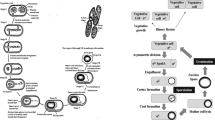Abstract
An experimental equipment for dry-heat inactivation of bacterial spores in an open system using Infrared (IR) radiation for energy transfer was developed. The dry-heat-inactivation kinetics forBacillus subtilis ATCC 6633 spores were studied in the temperature range of 120–180C. The z value (z=23C) was constant in the temperature range investigated. The advantages offered by using IR radiation in sterilization systems are pointed out.
Similar content being viewed by others
References
Alderton, G. andSnell, N. 1970. Chemical states of bacterial spores: Heat resistance and its kinetics at intermediate water activity.—Appl. Microbiol.19: 565–572.
Angelotti, R., Maryanski, J. H., Butler, T. F., Peeler, J. T. andCampbell, J. E. 1968. Influence of spore moisture content on the dry heat resistance ofBacillus subtilis var.niger.—Appl. Microbiol.16: 735–745.
Bigelow, W. D. 1921. The logarithmic nature of thermal death time curves.—J. Infect. Dis.29: 528–536.
Brannen, J. P. andGarst, D. M. 1972. Dry heat inactivation ofBacillus subtilis var.niger spores as a function of relative humidity.—Appl. Microbiol.23: 1125–1130.
Drummond, D. W. andPflug, I. J. 1970. Dry heat destruction ofBacillus subtilis spores on surfaces: Effect of humidity in an open system.—Appl. Microbiol.20: 805–809.
Fox, K. andEder, B. D. 1969. Comparison of survivor curves ofBacillus subtilis spores subjected to wet and dry heat.—J. Food Sci.34: 518–521.
Härnulv, B. G. andSnygg, B. G. 1972. Heat resistance ofBacillus subtilis spores at various water activities.—J. Appl. Bacteriol.35: 615–624.
Hoffman, R. K., Gambill, V. M. andBuchanan, L. M. 1968. Effect of cell moisture on the thermal inactivation rate of bacterial spores.—Appl. Microbiol.16: 1240–1244.
Jacobs, R. A., Nicholas, R. C. andPflug, I. J. 1965. Heat resistance ofBacillus subtilis spores in atmospheres of different water contents.—Mich. Agr. Exp. Sta. Quart. Bull.48: 238–246.
Murrell, W. G. andScott, W. J. 1966. The heat resistance of bacterial spores at various water activities.—J. Gen. Microbiol.43: 411–425.
Oag, R. K. 1940. The resistance of bacterial spores to dry heat.—J. Pathol. Bacteriol.51: 137–141.
Pheil, C. G., Pflug, I. J., Nicholas, R. C. andAugustin, J. A. L. 1967. Effect of various gas atmospheres on destruction of microorganisms in dry heat.—Appl. Microbiol.15: 120–124.
Author information
Authors and Affiliations
Rights and permissions
About this article
Cite this article
Molin, G., Östlund, K. Dry-heat inactivation ofBacillus subtilis spores by means of infra-red heating. Antonie van Leeuwenhoek 41, 329–335 (1975). https://doi.org/10.1007/BF02565067
Received:
Issue Date:
DOI: https://doi.org/10.1007/BF02565067



